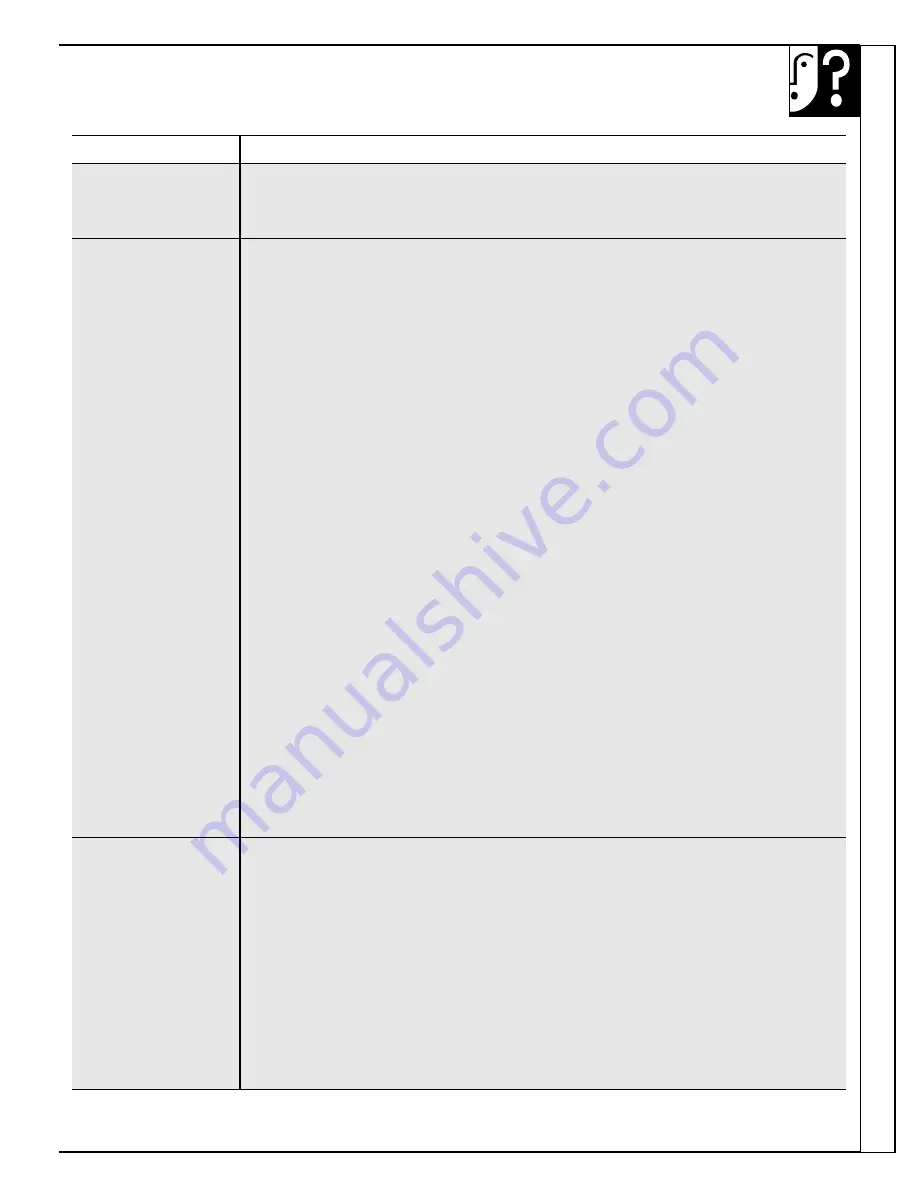
The Pr
oblem Solver
PROBLEM
POSSIBLE CAUSE
LINT OR RESIDUE
To correct—
ON CLOTHES
All residue except pilling can usually be removed from garments through use of correct
IN CYCLE
laundry procedures.
(continued)
SNAGS, HOLES,
• Pins on garments or sharp objects left in pockets. Remove all pins, check pockets
TEARS, RIPS OR
of all garments before putting in washer. Also check washer to see if any objects
EXCESSIVE WEAR
remained in wash tub.
• Snaps, hooks, sharp buttons, belt buckles, zippers. Make sure all hooks, snaps and
buttons are fastened. Remove sharp buttons and belt buckles. This is very important
when washing knits, which snag easily. Turn knits inside out.
• Improper use of chlorine bleach. Holes may have random square shape; yellow
discoloration, fabric will be weak at edges of hole.
(a) Use only correct, measured amount of bleach.
(b) Never add undiluted bleach to washer tub nor allow clothes to come in
contact with undiluted bleach. Do not wipe up bleach spills with clothes.
(c) Damage from chemicals such as hair preparations (bleach, dye, home permanent
solution), battery acid, some toilet bowl cleaners. Immediately rinse towels and
other articles thoroughly which have come in contact with these chemicals before
putting them in washer. Avoid contaminating items of clothing with such chemicals.
• Small, unnoticed holes, tears or ripped seams may enlarge during washing.
Check garments carefully before loading washer and mend all rips and tears.
• As permanent press garments age, they may show fraying at collars and cuffs. This
is due to the weakening of the fibers by the permanent press process. It is not caused
by the washer. you can slow this process by washing small permanent press loads
with a large water level. Do not wash heavy items such as towels with permanent.
press When possible, remove collar stays.
• Roughness or burrs on agitator due to damage incurred by heavy belt buckles, etc.
Examine agitator for roughness or burrs and smooth by filing if necessary.
• May be using wrong cycle for delicate fabrics. Use delicate cycle. Refer to garment
manufacturer’s care instructions.
• Garments weakened by aging, sun or atmosphere. This is an inevitable process
and is not caused by the washer. You may slow down process by use of delicate cycle.
• Too little water in washer or too large a load. Load washer only with the number of
items that will move freely. Select correct water level.
WRINKLING IN
• Leaving clothes in dryer after tumbling stops. Immediately after dryer stops
PERM PRESS AND
tumbling, remove clothes and place them on hangers.
“NO-IRON” ITEMS
• Too many items in dryer. Dry only one washer load at a time. Do not combine loads.
• Too few items in dryer. If drying only one article, add two or more similar articles,
even if dry, to insure proper tumbling.
• Improper loads. Avoid laundering heavy permanent press items, such as work
clothes, with lighter permanent press items such as shirts or blouses. Also do not
wash or dry permanent press items with regular laundry.
• Too many items in washer. Items must have room to move freely. Permanent press
loads should always be smaller than regular loads…no more than medium loads.
• Use of incorrect wash and dry cycles. Use permanent press wash cycle which
provides a cool-down rinse to minimize wrinkling. Also, use automatic dry cycle.
(continued next page)
There is no solution
once this type of
damage has occurred.
23
Summary of Contents for Unitized Spacemaker WSM2420
Page 25: ...25 The Problem Solver NOTES...
Page 26: ...26 NOTES...






































